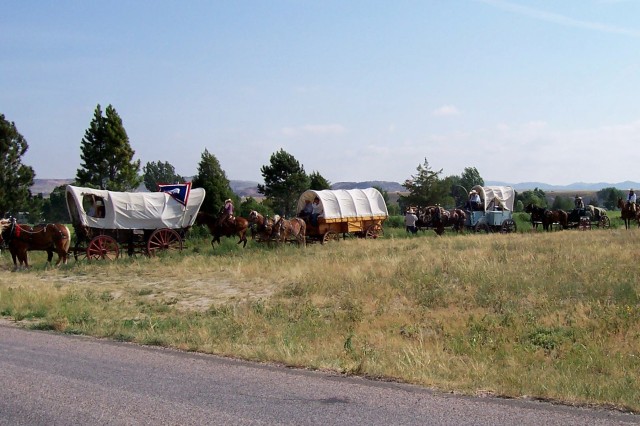ABERDEEN PROVING GROUND, Md. -- The Wyoming Army National Guard's Camp Guernsey won the FY 2009 Secretary of the Army award for cultural resources management on an installation.
Camp Guernsey was recognized for the efforts of its cultural resources management office in researching, preserving, and collecting data from historic sites as an integral part of enhancing the installation's primary mission as a field artillery training center. The camp is an ideal training site for all U.S. military Services, as it shares a similar terrain with that of Afghanistan.
Camp Guernsey has made stewardship and preservation of its numerous cultural and historical resources a main focus during the last two years. Because multiple units in all branches of U.S. military Services rely on the installation for training; conservation and protection of the installation's cultural resources is viewed as critical to mission readiness.
"Wyoming Army National Guard does an excellent job informing the troops that train at Camp Guernsey of cultural resources concerns and responsibilities," said Sarah Killinger, liaison to the Army, Advisory Council on Historic Preservation.
One of the principal accomplishments of Camp Guernsey's cultural resources management office was the installation's documentation of procedures to mitigate the effects of wildfire incidents on Native American cultural sites. To complete this initiative, Camp Guernsey's CRM office was able to obtain $44,000 in Department of Defense (DoD) Legacy Project funding, and the study was completed in late 2008.
The DoD Legacy program assists in protecting and enhancing resources while supporting military readiness. A Legacy project may involve regional ecosystem management initiatives, habitat preservation efforts, archaeological investigations, invasive species control, Native American consultations and/or monitoring and predicting migratory patterns of birds and animals.
"Wyoming ARNG takes its responsibility as stewards of their land very seriously, respecting the history and traditions of the Native American tribes and settlers that lived there before, and protecting that heritage for future occupants," said Killinger.
The cultural resources management staff followed a six step process to complete the objective of this project. The first step was to collect and synthesize existing data on fire and fire impacts. Next, they organized a symposium where Native Americans associated with traditional cultural properties worked with archaeologists and land managers to determine proper damage assessment methods.
The data gleaned from the symposium was then synthesized into a draft standing operating procedure called an SOP. The fourth step included review of the draft SOP by symposium participants. The fifth step in the project was to revise the SOP based on input from tribal members, archaeologists, and land managers. The last step was the creation and distribution of the final document to the Legacy program, tribal members and participating land management agencies.
Protecting traditional cultural sites prior to and during fires and assessing post-fire damage are issues that will continue to increase as more of these traditional cultural properties are recorded on DoD lands and as arid conditions persist across parts of the country.
This project benefits the entire Defense Department by creating procedures that can be used across military services by any installation that has traditional cultural properties under its jurisdiction. The nation as a whole also benefits in this project from the support of the Forest Service, National Park Service and Bureau of Land Management.
Camp Guernsey also completed a Native American ethnographic study and cultural property survey in 2008. The study incorporated contributions from archaeologists, historians and tribes, and the final report captures the archaeological and ethnographic history of the region, accounts of treaties and tribal life and background on traditional use areas and resources, including plants, animals, minerals and water. Particular emphasis was placed on specific sites and features identified as important to the tribes.
The cultural resources management office provided tribal representatives the opportunity to give specific recommendations for management of traditional sites, review documents and offer approval on proposed activities. A tribal monitoring program is also in place for ground-disturbing projects; tribes visit on a rotating basis to participate in fieldwork and surveys.
An independent panel of judges made up of professionals from federal, state and Army organizations recommended WYARNG for the award. The Secretary of the Army Environmental Awards represent the highest honor in the field of environmental science and sustainability conferred by the Army, and Camp Guernsey will go on to compete in the cultural resources management category at the Secretary of Defense Environmental Awards later this year.
Deputy Assistant Secretary of the Army for the Environment, Safety and Occupational Health Tad Davis recognized Camp Guernsey and the winners of the other eight categories as the best examples of how environmental stewardship and sustainability play a crucial role in the Army's mission readiness.
"The Army recognizes successes that demonstrate mission-driven solutions that protect the environment at installations here and overseas. Whatever we do needs to revolve around supporting the mission, taking care of our Soldiers, civilians, and Families," said Davis. "In simplistic terms the Army, our Army, your Army - is building green, buying green and going green. These winning environmental programs make the Army sustainable thereby impacting generations to come."
For details about the Secretary of the Army Environmental Award recipients, visit the U.S. Army Environmental Command's Web site at http://aec.army.mil/usaec/newsroom/awards00.html.












Social Sharing